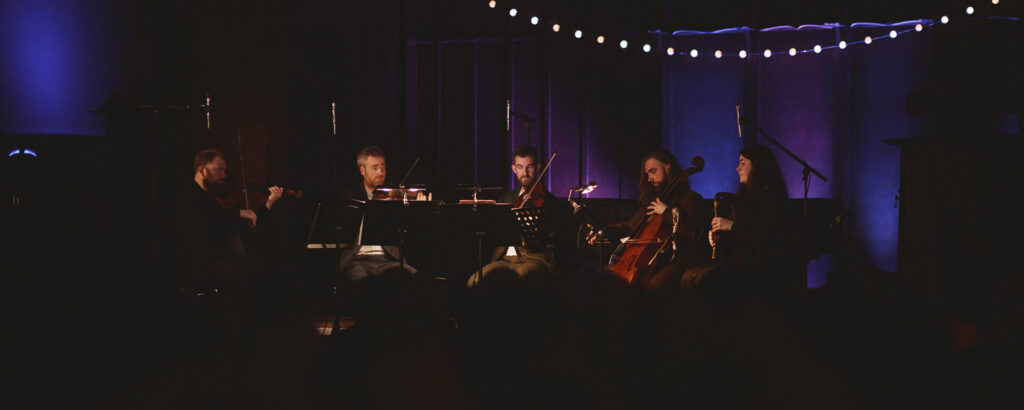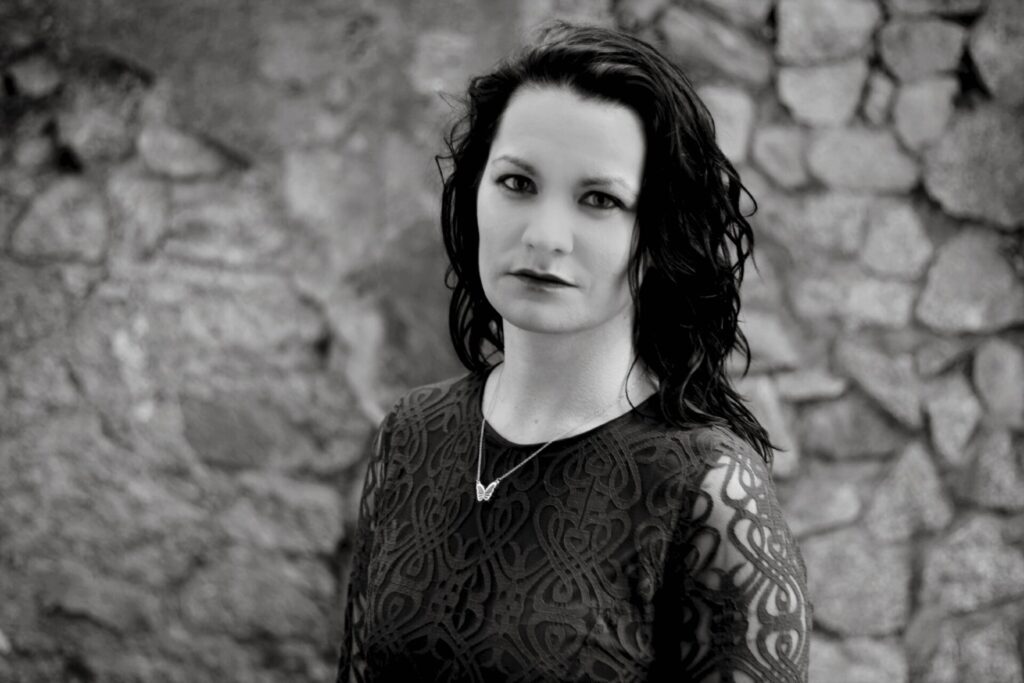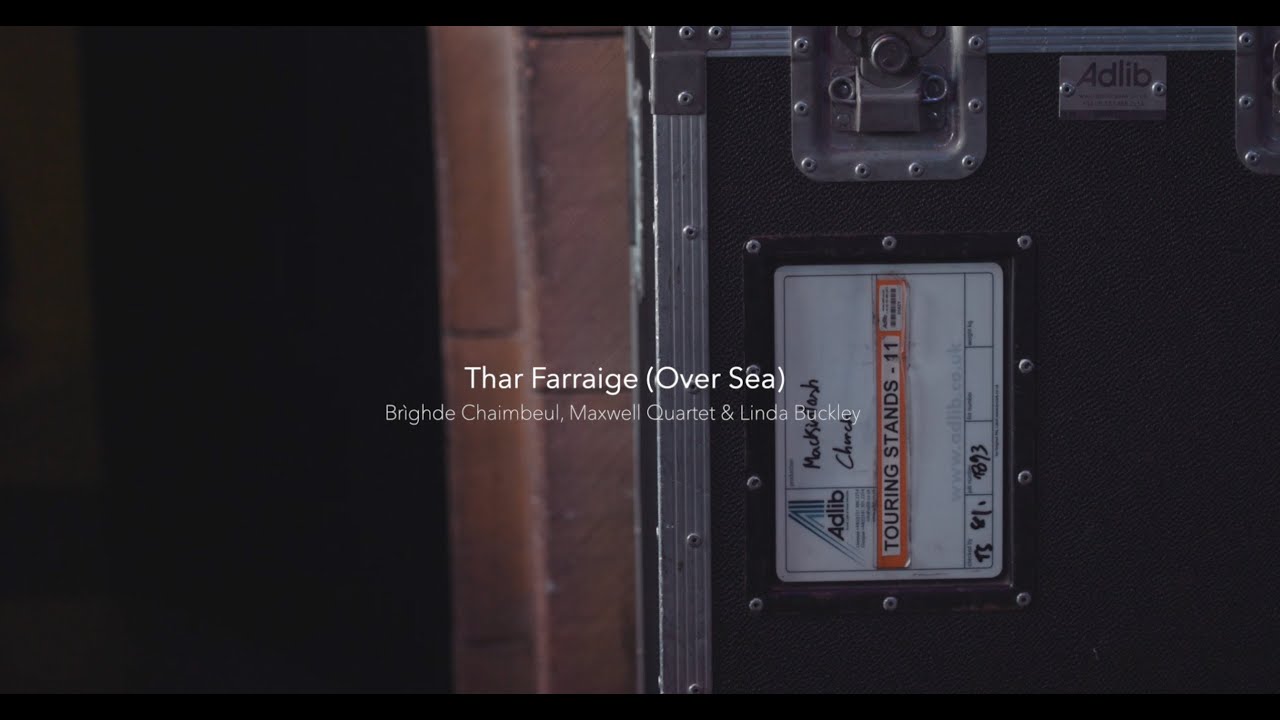In her composition Thar Farraige (Over Sea), award-winning composer Linda Buckley weaves together several threads. Commissioned by Chamber Music Scotland, the work combines chamber music and folk song, Irish and Scottish traditional music and language, as well as electronics, blurring the boundaries of where each sound source begins and ends; the drones of Scottish smallpipes and the playing of a string quartet interweaving, coalescing, departing and reuniting. Themed around ideas of migration and our connection to place, Buckley’s melodic lines draw at different times from Irish keening and Gaelic psalm singing, while elsewhere she movingly employs a scratchy phone recording of a poem read by her mother, ‘The Moon Behind The Hill’, in which the narrator looks back with both warmth and sorrow at a homeland they’ve long since left behind.
Buckley’s mother died during the early stages of Thar Farraige’s creation, which, as she explains in our interview below, gave the piece a deeper personal significance – the sorrow of seeing a loved one depart through emigration intermingling with the grief of a close family member’s death. It makes for music that’s has both an intimate power and a sense of widescreen immersion, a balancing act achieved not only by Buckley’s compositional skill, but by the strength of her musicians.
The piece is to be performed on 8 June at Bradford’s Loading Bay and on 6 July at London’s Southbank Centre, as part of the New Music Biennial. In Bradford, Brìghde Chaimbeul, a player in the majority of Thar Farraige performances thus far, will be playing the Scottish smallpipes, while in London Ailis Sutherland will take her place.
Says Chaimbeul over email: “Thar Farraige is a wonderful example of how the pipes can fit so well into a contemporary ensemble setting, Linda Buckley wrote a part that is weaving the instrument into the string quartet, breaking away from the separation that often comes between instruments of a traditional music background and ensembles of a classical background.
“Much of my own music is rooted in tradition and so I often think about the way the music has travelled, changed and survived across waters and generations. This is a theme that is present in different ways in the piece and one I resonate with. There’s a sense of tender memory in the music.”
At both shows, meanwhile, strings will be provided by the acclaimed Maxwell Quartet.
“Working on Thar Farraige with Linda and Brìghde was a fascinating experience as it allowed us to delve into an altogether different sound world to the standard string quartet experience,” The Maxwell Quartet tell tQ over email. “The pipes offer a really different texture and harmonic temperament which encourages us to look past our usual ‘rules’ of tuning and blending, and to create an entirely different string quartet sound. The addition of the electronics also plays a key role in that alternative sound, which feels both ancient and modern, straddling these two worlds in a kind of dream-like status…
“We’re really honoured to have had the opportunity to take the string quartet repertoire somewhere completely new, and it has been amazing to see so far how this piece has resonated with so many different audiences,” they continue.
Below, meanwhile, we speak to Buckley in depth about the story behind Thar Farraige, writing for her dream collaborators, formative musical experiences from foghorns and milking machines, how it was shaped by her mother’s death, and more.
Could you tell us about the earliest stages of Thar Farraige (Over Sea)? How did the composition begin?
Linda Buckley: It was through working with Chamber Music Scotland; I was invited to be their associate artist. They asked me what my dream project would be, who I’d like to work with, and I said Brìghde Chaimbeul and The Maxwell Quartet. Then they went through the process of getting a commission from PRS Beyond Borders. I was involved in writing a proposal, which was to do with themes of immigration, connection and loss of connection, but then, my mother died suddenly when I was starting to write the piece, so it took quite a different turn. It was a huge shock, a huge loss, and started a huge journey of grief, so the piece became more about that. But I think it’s all connected in terms of our sense of home, love and loss, and meditating on that.
Can you tell me more about your own connection to those themes?
LB: I’m the youngest of nine children, and we grew up on a dairy farm in a remote place in Cork, The Old Head of Kinsale. So I suppose the interest for me in immigration is because I moved to Glasgow in 2018. I’m still back and forth all the time between the two countries. I think when you leave your home, it makes you think a lot about where you come from, and gives you another perspective on your sense of Irishness. I also lived in New York for a year in 2016, I think I was already starting to think about it at that stage.
Your grandfather also emigrated from Ireland to New York, where he was one of the people who worked on the construction of the Empire State Building.
LB: That’s right, and I never met him because he died before I was born. It felt very fitting to connect to that, because after my mother died I was thinking a lot more about her family and her background. It was always an amazing thing that he had taken the boat to America in the 1920s and ended up living there for nine years in the Bronx. Then he saved money and bought a farm in West Cork – so there was that sense of return as well. I always thought that was kind of a beautiful thing.
When your mother passed away, how far along was this project?
LB: It was at the very beginning. I was working on it at a residency in Northeast Scotland, in Arbroath, and I was walking along the cliffs one day. I took out my phone and I found some recordings of her voice, so I knew that that had to be a part of the piece as well. The third movement has her reading out a poem which felt very connected to immigration and displacement, but also I just really wanted her to be a part of it?
What was the poem?
LB: The Moon Behind The Hill, which was sung by Joe Heaney when he lived in America, the Irish singer from Connemara. It’s all about, I suppose, loss, and a sense of yearning for your home place.
Why had you initially recorded your mother recounting it?
LB: At the beginning of lockdown, I was in Scotland and the rest of my family were in Ireland, and I had this horrible feeling, when we didn’t know what was going to happen, around not knowing who would survive it. Sometimes she would be on the phone to me, and I just would want to record her voice so that I had it. It was done in a really lo-fi, grainy way, where she was on the landline and I recorded it on my mobile, and I think there’s something kind of beautiful about that.
Why had you singled out Brìghde Chaimbeul and The Maxwell Quartet in particular when asked who you’d like to work with?
LB: There’s something about Brìghde where she’s deeply rooted in the tradition, especially of Scottish folk music, but there’s also an openness to experimentation in what she does, and very bold performances – extreme repetition and the minimal made maximal. There’s this momentum that’s built up through the repeating patterns and phrases, just wanting to push it all the time. I think it’s amazing. Then, The Maxwell Quartet, they’re a classical string quartet but many of them are very much rooted in folk music as well, so they have a really deep understanding of it, almost in terms of fiddle-playing, which is a part of this piece.
I’m always interested in bringing instruments together that are maybe from different worlds and making them one. So I suppose in this piece, I play a lot with the rules. Sometimes [Chaimbeul’s pipes and the string quartet] are all very unified, and other times they break away from each other and it’s blurring the boundaries of sounds. There’s electronics in the piece as well. I love playing with the idea of wondering what are pipes, what are strings, and what is electronic. Are they all merged together? Are they diverging? It’s something I’m interested in in all my music, playing with the idea of ‘what’s the origin of a sound?’
You’ve said in the past that some of your foundational musical influences growing up came from sources like your mother being tone deaf, and how she’d sing in quite an atonal and dissonant style, and also the sound of foghorns and milking machines that were around you on the farm. Can we trace it all the way back to that?
LB: Absolutely you can. That makes total sense to me. You don’t realise it in the moment, but in hindsight it’s all been connected to the fact that one of my earliest memories of sound is the sound of the foghorn, which has this very haunting resonance. The sound being physically diffused through fog, so it has this natural sense of reverberance, and I’m always really drawn to reverberant music. When I was young, my older siblings were bringing in records by Cocteau Twins and people like that, and there was a sense of developing that resonance and harmony that I’ve always loved. Then, with milking machines, they’re quite rhythmic and industrial sounding, but they have a drone as well. I used to love going in and singing with the drones – little snatches of melody, Irish songs, that sort of thing.

Bridghe’s music in particular is heavily drone based.
LB: It’s always so inspiring to watch her in rehearsal, how specific that drone is, and the tuning of it. When people are at performances of hers, they’re under the spell, closing their eyes and getting lost in it – I love seeing that. She’s playing festivals across the world and there’s queues down the street to listen to this very ancient Scottish folk music, and because she’s put so much of herself into it she’s almost in a hypnotic trance.
Are the pipes challenging to write for?
LB: It’s a challenge in a lovely way, because there are certain restrictions, but then they lead you in a certain way. Sometimes, when you’re working on music, when there’s so many possibilities open to you it’s hard to pin it down, but with this, you’re literally working with one octave of pitches in terms of melodic lines, and then playing with drones. So that’s why, in this piece, I really wanted to lean into the drone aspect.
Can you tell us more about how themes of immigration and migration are conveyed through a piece that’s almost entirely instrumental?
LB: Certain things happen in certain sections that are very specific, so in the first section, the melody lines all come from keening – Irish lamenting – which I suppose is a connection to the sense of Irishness and loss. Often, in sean-nós song, you would have mention of those leaving to go to a foreign place and they would never return, so I suppose keening is partly to do with lamenting the loss of people who have gone away and moved to other climes. I was also very interested in Gaelic psalm singing, where you get these very close melody lines that follow each other, and you get that in the first section [of Thar Farraige] where the pipes and strings are all pretty much playing the same lines, but just slightly staggered against each other, and that’s a connection to the islands of Scotland. So, I suppose it’s not necessarily tied in with immigration, but it’s tied to a sense of place, placing the music in a certain landscape. Then, I think by using a lot of slides in the strings and what Brìghde’s doing. There’s a section where everyone is sliding upwards. It’s about moving off to maybe an otherworldly place that we can’t reach, that’s maybe beyond us, which is probably tied in with what was happening with my mother – the poem read by her is very much about displacement and wanting to return as well. Then the last section is about letting go. ‘Slán Abhaile’ [which is the name of the last movement] is something you’d say to someone going home, so it’s almost like a return at the end. It might seem quite abstract to the ears, but that was what was in my mind when I was writing.
You’ve performed the piece a number of times now, in Northern Ireland, in Scotland, and further afield like the Netherlands and Norway. Have you noticed any difference in audience’s reactions and interpretations depending on where you play?
LB: I think it does change, there was a feeling of, I think, something to do with connection that I felt in its performances in Scotland and Ireland. And then you wonder, will certain things get lost in translation in other places like the Netherlands or Norway? But I was moved by how people responded to it and how moved they were by it, and how a lot of them, without any overt explanation, had a strong sense of what it was about, without having to over explain it.
Thar Farraige (Over Sea) is performed as part of New Music Biennial 2025 – a festival presented in partnership by PRS Foundation, Southbank Centre, and Bradford 2025 City of Culture. Free tickets for Bradford (6 to 8 June) and Southbank Centre (4 to 6 July) are now available.
Each festival weekend will be a PRS Foundation 25th Anniversary badged event. Thar Farraige (Over Sea) is a Beyond Borders commission – a cross-nations initiative supporting new work tours across the UK and Ireland, delivered in partnership with Creative Scotland, Arts Council of Wales, Arts Council of Northern Ireland and Arts Council Ireland.




